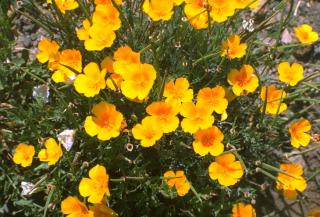California Poppy (Eschscholzia californica)

By Julie Kierstead Nelson

California poppy, the state flower of California, is native to the Pacific slope of North America from Western Oregon to Baja California. Adelbert von Chamisso, naturalist aboard the Russian exploring ship "Rurick”, discovered and named the species. The Rurick visited Alaska and California in 1816 under the command of Lieutenant Otto von Kotzebue. Chamisso named the California poppy Eschscholzia californica in honor of J. F. Eschscholtz, the ship's surgeon and entomologist (note that he accidentally left the “t” out of Eschscholtz’s name).
Seeds of this plant were introduced into English gardens in the nineteenth century. Seed catalogs now offer many different colors. California poppies have been planted in most of the United States and have become established along roadsides, in empty lots, and other disturbed places. In California, it is hard to tell any more which poppies are native wildflowers and which are garden escapes.

California poppies are easy to grow. Sow the seeds shallowly (1/16-inch deep) in fall or early spring in mild, wet winter climates, including most of California west of the Sierra-Nevada. Seeds will germinate after the first fall rains or when the soil warms in the spring. In hot summer areas, the poppies will bloom in spring and early summer, and then the tops will die back and the plants become dormant during the heat of the summer. The poppy survives in the form of a fleshy taproot. In cooler coastal climates, California poppies may bloom most of the summer. Sandy, well-drained soil in full sun is best. No supplemental watering is required unless the growing season is exceptionally dry.
In mild-winter climates, these poppies will survive several years, resprouting each fall. They will reseed themselves if they are happy. Where winters are cold, the poppy behaves as an annual, renewing itself from seed each year. The flowers of California poppy close each night, and on cloudy days. Enjoy them where they grow. If you pick California poppies for a wildflower bouquet, you will be disappointed when the petals almost immediately fall off.
For More Information
PLANTS Profile - Eschscholzia californica, California poppy
